
Sirvan Najafi
Department of Audiology, Arak University of Medical Sciences, IranTitle: The combined transcranial direct current stimulation (tDCS) and tailor-made notched music training (TMNMT) in treatment of tinnitus patients
Abstract
Tinnitus network(s) consists of pathways in the auditory cortex, frontal cortex, and the limbic system. The cortical hyperactivity caused by tinnitus may be suppressed by neuromodulation techniques. Due to the lack of definitive treatment for tinnitus and limited usefulness of the individual methods, in this study, a combination of transcranial direct current stimulation (tDCS) over the dorsolateral prefrontal cortex (DLPFC) and tailor-made notched music training (TMNMT) was used.
In this descriptive-analytic study, 26 patients with chronic unilateral tinnitus of the right ear were randomly divided into the clinical trial group (CTG) and the control group (CG). In both groups, six sessions of tDCS with 2mA intensity for 20 minutes, with anode on F4 and cathode on F3, were conducted. Simultaneous with tDCS sessions, and based on TMNMT, the participant was asked to listen passively for 120 minutes/day, to a CD containing her/his favorite music with a proper notch applied in its spectrum according to the individual’s tinnitus.
The treatment outcome was measured by, psychoacoustic (loudness-matching), psychometric (awareness, loudness and annoyance Visual Analogue Scale (VAS) scores, and Tinnitus Handicap Inventory (THI)) scores, and cognitive assessments (randomized dichotic digits test (RDDT) and dichotic auditory verbal memory test (DAVMT)).
Repeated measurement test was used for statistical analyses. In the CTG, the tinnitus loudness and annoyance VAS scores, and THI were reduced significantly (p=0.001).
In addition, the DAVMT and RDDT scores were enhanced (p=0.001). Such changes were not observed in the CG (p>0.05).
The combination of tDCS and TMNMT led to a reduction in the loudness, awareness, annoyance, and also disability induced by tinnitus in CTG. Furthermore, this method showed an improvement of cognitive functions (auditory divided attention, selective attention and working memory) in the CTG.
Biography
My Name is Sirvan Najafi. I’m 31 years old and completed my Ph.D of Audiology from University of Social Welfare and Rehabilitation Sciences, Tehran, Iran.
Now, I’m attending as Assistant Professor of Audiology at department of audiology, school of rehabilitation, Arak University of Medical Sciences, Arak, Iran.
My field on interest is tinnitus, vertigo and electrophysiological tests.
Based on Google Scholar, my publication H-index is 3. I am serving as an editor member of Journal of Otolaryngology-Head & Neck Surgery.

